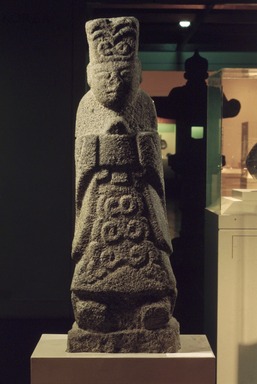
Medium: Granite
Geograhical Locations:
Dates:15th–16th century
Dimensions: 53 x 14 in. (134.6 x 35.6 cm)
Collections:
Accession Number: 85.18
Image: 85.18.jpg,
Catalogue Description: The present Tomb Guardian represents a high ranking court minister standing fully frontal in an attitude of reverance. He is a civil official rather than a military one. He wears Confucian court costume with a full length robe, pendant sleeves and a boxlike court hat. The toes of court shoes appear beneath the edge of his robe. A ceremonial apron indicating court rank hangs from his belt. His hands are clasped before his chest holding a wooden baton of office of the type carried at an audience with the king. A stone image such as this was meant to serve symbolically the deceased king as a loyal court minister in the spirit world. Pairs of figures such as this stood on either side along the avenue leading to an important person's tomb. From original catalogue card. Condition: Tip of nose broken away. Surface somewhat weathered. This "civil minister stone" (muninseok) of the late Joseon dynasty was a burial item used to decorate the graves of Joseon elites. It would have been placed on a burial site along with other stone figures such as a "military minister stones" (muinseok) and animals. The tradition of adorning graves with various human and animal stone sculptures dates back to the Unified Silla period, when people began to honor deceased royals and aristocrats by erecting various stone forms around their graves. The highly stylized depiction of the figure and the lack of details lead art historians to believe that this was carved at a relatively recent date. From "Korean Art Collection in the Brooklyn Museum" catalogue.